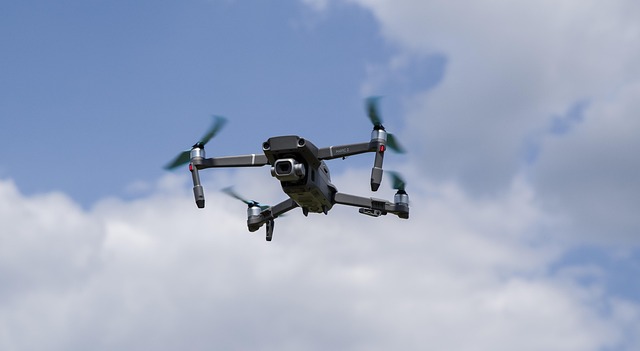Drone technology, once a novelty, has become a significant global security concern due to their widespread accessibility and advanced capabilities. Unmanned Aerial Vehicles (UAVs) pose unique challenges for securing sensitive locations as they can penetrate tight spaces and bypass traditional security measures. Effective drone-based security systems require identifying high-value targets like military bases and critical infrastructure, followed by risk assessment and vulnerability analysis. Physical security measures such as fences, sensor networks, and no-fly zones are crucial, along with advanced technology solutions like radar, lidar, and AI for detection and interception. Regulatory frameworks and international cooperation are essential, with future strategies focusing on technological advancements to combat evolving drone threats.
In the age of advanced technology, drones pose a growing threat to sensitive locations worldwide. This article delves into the critical issue of protecting against drone-based espionage and attacks, exploring comprehensive strategies for securing at-risk areas. We examine various types of drones and their capabilities, risk assessment techniques, and cutting-edge physical and technological countermeasures. Additionally, we analyze international regulations and collaborative efforts to combat this evolving challenge, offering insights into future prevention strategies for enhanced drone-based security systems.
Understanding the Drone Threat: Types and Capabilities
Drone technology, once a novelty, has evolved into a significant concern for security professionals worldwide. Unmanned Aerial Vehicles (UAVs), or drones, are now accessible and affordable enough to be operated by individuals with minimal training, posing a unique challenge to sensitive locations. These drones can be equipped with high-resolution cameras, thermal imaging sensors, and even weapons, making them capable of gathering intelligence, surveillance, and conducting attacks from the sky.
The versatility of drone-based security systems is both a strength and a weakness. While they offer unprecedented aerial capabilities for monitoring vast areas, their small size and advanced features enable them to penetrate tight spaces and avoid traditional security measures. This has led to an increase in incidents involving unauthorized drones flying into restricted airspaces, capturing sensitive imagery, and even delivering harmful packages. Understanding these diverse drone types and their evolving capabilities is crucial in developing robust countermeasures to protect against this emerging threat.
Identifying Sensitive Locations: Risk Assessment and Vulnerability Analysis
Identifying sensitive locations is a critical first step in safeguarding them from potential drone-based espionage or attacks. This involves a comprehensive risk assessment that considers geographical, infrastructural, and strategic factors. For instance, military bases, government facilities, power plants, water treatment centers, and critical communication towers are all high-value targets due to their significance to national security and public services.
A thorough vulnerability analysis should then be conducted to identify weaknesses in existing security measures. This includes assessing the visibility of these locations from the air, the presence of physical barriers, surveillance capabilities, and current response protocols. By understanding these vulnerabilities, stakeholders can make informed decisions about where to focus their resources, ultimately enhancing the effectiveness of drone-based security systems.
Implementing Physical Security Measures Against Drones
Implementing physical security measures is an essential step in protecting sensitive locations from drone-based espionage or attacks. This includes deploying physical barriers like high fences, walls, and booms that can deter drones from approaching. Additionally, integrating sensor networks—such as motion detectors and infrared cameras—can provide early warning systems for unauthorized drone incursions. These measures should be designed to disrupt drone navigation, either through signal jamming or visual/audio disorientation techniques.
Furthermore, establishing no-fly zones with reinforced ground-based defenses can significantly enhance security. This may involve the strategic placement of guard posts, patrol teams, and advanced surveillance equipment. By combining these physical security systems with robust drone-based security systems, organizations can create a multi-layered defense that makes it increasingly difficult for drones to operate in prohibited areas undetected.
Advanced Technology Solutions for Drone Detection and Interception
Advanced technology solutions are transforming drone-based security systems, offering unprecedented capabilities for detection and interception. Radar and lidar systems play a crucial role in identifying and tracking drones by their unique radio frequency signatures and light patterns. These technologies can pinpoint drone locations with remarkable accuracy, enabling authorities to take swift action against unauthorized intrusions.
Furthermore, artificial intelligence (AI) enhances these systems by analyzing real-time data streams, learning patterns of normal flight behavior, and automatically detecting anomalies. Once a potential threat is identified, specialized countermeasures, such as high-power microwave pulses or laser interference, can be deployed to disrupt drone operations, ensuring the protection of sensitive locations from drone-based espionage or attacks.
Regulatory Frameworks, International Cooperation, and Future Prevention Strategies
Regulatory Frameworks play a pivotal role in countering the threats posed by drone-based espionage and attacks. Many countries have started to implement stringent laws and guidelines to govern the use of drones, emphasizing safety and security measures. These frameworks often include licensing requirements for drone operators, restrictions on flight paths near sensitive areas, and mandated technology for identifying and tracking drones. International Cooperation is another crucial aspect; shared intelligence and joint operations between nations can significantly enhance drone security. Countries worldwide are collaborating to establish standardized protocols, ensuring that border regions are well-protected.
Future Prevention Strategies should focus on technological advancements in drone security systems. This includes developing counter-drone technology, such as advanced radar systems and jamming devices, to intercept and neutralize unauthorized drones. Additionally, investing in secure communication networks and data encryption can prevent the interception of sensitive information. As drone technology evolves, so must our defenses; regular updates and simulations to test these measures are essential to stay ahead in this dynamic landscape.
Protecting sensitive locations from drone-based espionage or attacks requires a multifaceted approach. By understanding the evolving capabilities of drones through risk assessment and vulnerability analysis, we can implement robust physical security measures and leverage advanced technology solutions for detection and interception. Moreover, regulatory frameworks and international cooperation play a crucial role in preventing and mitigating these threats. Integrating these strategies fosters a comprehensive drone-based security system, ensuring safer and more secure environments for all.
